Westland Lysander Videos
|
Loading...
|
|
Westland Lysander
Lysander
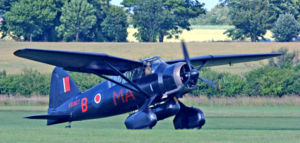
Picture - Westland Lysander Mk III(SD), the type used for special missions into occupied France during World War II.
Role: Army co-operation and liaison aircraft
Manufacturer: Westland Aircraft
Designed by: Arthur Davenport, Teddy Petter
First flight: 15 June 1936
Introduction: June 1938
Retired: 1946 (UK)
Primary users: Royal Air Force
Royal Canadian Air Force
Egyptian Air Force
United States Army Air Forces
Number built: 1,786
The Westland Lysander was a British army co-operation and liaison aircraft produced by Westland Aircraft. It was used during the Second World War. The aircraft's exceptional short-field performance made possible clandestine missions using small, unprepared airstrips behind enemy lines that placed or recovered agents, particularly in occupied France. Like other British army air co-operation aircraft it was given the name of a mythical or legendary leader, in this case Spartan general Lysander.
Design and development
In 1934 the Air Ministry issued Specification A.39/34 for an army co-operation aircraft to replace the Hawker Hector. Initially Hawker Aircraft, Avro and Bristol were invited to submit designs, but after some debate within the Ministry, a submission from Westland was invited as well. The Westland design, internally designated P.8, was the work of Arthur Davenport under the direction of W.E.W. (Teddy) Petter. It was Petter's second aircraft design and he spent considerable time interviewing Royal Air Force pilots to find out what they wanted from such an aircraft. The result of Petter's enquiries suggested that field of view, low-speed handling characteristics and STOL performance were the most important requirements.
Davenport and Petter worked to design an aircraft around these features: the result was unconventional and looked, by its 15 June 1936 maiden flight, rather antiquated. The Lysander was powered by a Bristol Mercury air-cooled radial engine and had high wings and a fixed conventional landing gear faired inside large, streamlined spats. The spats had mountings for small, removable stub wings that could be used to carry light bombs or supply canisters. It looked not dissimilar to the Polish LWS-3 Mewa. The wings had an unusual reverse taper towards the root, which gave the impression of a bent gull wing, although in fact the spars were perfectly straight. It had a girder type construction with a light wood frame around that to give the aerodynamic shape. The forward part was duralumin tube joined with brackets and plates,and the after part welded stainless steel tubes. Plates and brackets were cut from channel extrusions rather than forming from sheet steel. The front spar and lift struts were extrusions. The wing itself was fabric covered.
Despite its appearance, the Lysander was aerodynamically advanced; it was equipped with fully automatic wing slots and slotted flaps and a variable incidence tailplane. These refinements gave the Lysander a stalling speed of only 65 mph (104 km/h, 56.5 knots). It also featured the largest Elektron alloy extrusion made at the time: a single piece inside the spats supporting the wheels. The Air Ministry requested two prototypes of the P.8 and the competing Bristol Type 148, quickly selecting the Westland aircraft for production and issuing a contract in September 1936.
Operational history
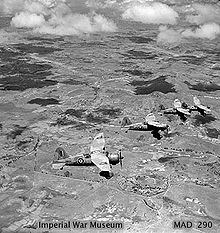
Picture - December 1942. Four Lysander Mk IIIAs of No. 1433 Flight RAF, based at Ivato, over a typical Madagascar landscape, shortly after the official end of the Madagascar campaign. (Photographer: Sgt J.D. Morris).
The first Lysanders entered service in June 1938, equipping squadrons for army co-operation and were initially used for message-dropping and artillery spotting. When war broke out in Europe, the earlier Mk Is had been largely replaced by Mk IIs, the older machines heading for the Middle East. Some of these aircraft, now designated type L.1, operated with the Chindits of the British Indian Army in the Burma Campaign of the Second World War.
Four regular squadrons equipped with Lysanders accompanied the British Expeditionary Force to France in October 1939, and were joined by a further squadron early in 1940. Following the German invasion of France and the low countries on 10 May 1940, the Lysanders were put into action as spotters and light bombers. In spite of occasional victories against German aircraft, they made very easy targets for the Luftwaffe even when escorted by Hurricanes. Withdrawn from France during the Dunkirk evacuation, they continued to fly supply-dropping missions to Allied forces from bases in England; on one mission to drop supplies to troops trapped at Calais, 14 of 16 Lysanders and Hawker Hectors that set out were lost. A total of 118 Lysanders were lost in or over France and Belgium in May and June 1940, of a total of 175 deployed. With the fall of France, it was clear that the type was unsuitable for the army co-operation role, being described by Air Marshall Arthur Barratt, commander-in-chief of the British Air Forces in France as "quite unsuited to the task; a faster, less vulnerable aircraft was required." It was replaced in the home-based army co-operation role from 1941 by camera-equipped fighters such as the Curtiss Tomahawk and North American Mustang carrying out reconnaissance operations, while light planes such as the Taylorcraft Auster were used to direct artillery. Some UK-based Lysanders went to work operating air-sea rescue, dropping dinghies to downed RAF aircrew in the English Channel. Fourteen squadrons and flights were formed for this role in 1940 and 1941.
Special duties
In August 1941 a new squadron, No. 138 (Special Duties), was formed to undertake missions for the Special Operations Executive to maintain clandestine contact with the French Resistance. Among its aircraft were Lysander Mk IIIs, which flew over and landed in occupied France. While general supply drops could be left to the rest of No. 138's aircraft, the Lysander could insert and remove agents from the continent or retrieve Allied aircrew who had been shot down over occupied territory and had evaded capture. For this role the Mk IIIs were fitted with a fixed ladder over the port side to hasten access to the rear cockpit and a large drop tank under the belly. In order to slip in unobtrusively the Lysanders were painted matt black; operations almost always took place within a week of a full moon, as moonlight was essential for navigation.
The Lysanders flew from secret airfields at Newmarket and later Tempsford, but used regular RAF stations to fuel-up for the actual crossing, particularly RAF Tangmere. Flying without any navigation equipment other than a map and compass, Lysanders would land on short strips of land, such as fields, marked out by four or five torches. They were designed to carry one passenger in the rear cockpit, but in case of urgent necessity three could be carried in extreme discomfort. The pilots of No. 138 and, from early 1942, No. 161 Squadron transported 101 agents to, and recovered 128 agents from Nazi-occupied Europe. The Lysander was successful in this role, and continued to undertake such duties until the liberation of France in 1944.
Free French
The Lysander also joined the ranks of the Forces Aériennes Franx§aises Libres (Free French Air Force, FAFL) when Groupe Mixte de Combat (GMC) 1, formed at RAF Odiham on 29 August 1940, was sent to French North-West Africa in order to persuade the authorities in countries such as Gabon, Cameroon and Chad, which were still loyal to Vichy France, to join the Gaullist cause against the Axis powers, and to attack Italian ground forces in Libya. As with all FAFL aircraft, the Lysanders sported the Cross of Lorraine insignia on the fuselage and the wings instead of the French tricolor roundel first used in 1914, to distinguish their aircraft from those flying for the Vichy French Air Force. The Lysanders were mostly employed on reconnaissance missions, but were also used to carry out occasional attacks. In all, 24 Lysanders were used by the FAFL.
Other duties
The type also filled other, less glamorous roles such as target-towing and communication aircraft. Two aircraft (T1443 and T1739) were transferred to British Overseas Airways Corporation (BOAC) for training and 18 were used by the Fleet Air Arm. All British Lysanders were withdrawn from service in 1946.
Export customers of the type included Finland (Mk I: 4, Mk III: 9), Ireland (Mk II: 6), Turkey (Mk II: 36), Portugal (Mk IIIA: 8), the United States (25), India (22) and Egypt (20). Egyptian Lysanders were the last to see active service, against Israel in the War of Independence in 1948.
A total of 1,786 were built, including 225 that were built under licence by National Steel Car in Toronto, Ontario, Canada during the late 1930s.
Civilian operation
After the war a number of surplus ex-RCAF Lysanders were employed as aerial applicators with Westland Dusting Service, operating in Alberta and western Canada. Two of these were saved for inclusion in Lynn Garrison's collection to be displayed in Calgary, Alberta.
Variants
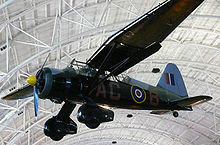
Picture - A Westland Lysander IIIA preserved at the Steven F. Udvar-Hazy Center
Lysander Mk.I Powered by one 890 hp (664 kW) Bristol Mercury XII radial piston engine. Two forward-firing 0.303 in (7.7 mm) Browning machine guns in wheel fairings and one pintle-mounted 0.303 in (7.7 mm) Lewis or Vickers K machine gun in rear cockpit. Optional spat-mounted stub wings carried 500 lb (227 kg) of bombs. Four 20 lb (9 kg) bombs could be carried under rear fuselage. Lysander TT Mk I Lysander Mk Is converted into target tugs. Lysander Mk II Powered by one 905 hp (675 kW) Bristol Perseus XII sleeve valve radial piston engine. Lysander TT Mk II Target tug conversion of the Lysander Mk.II. Lysander Mk III Powered by one 870 hp (649 kW) Bristol Mercury XX or 30 radial piston engine, 350 delivered from July 1940. Twin 0.303 in (7.7 mm) Browning guns in rear cockpit. Lysander Mk IIIA Similar to the Lysander Mk I. Mercury 20 engine. Twin 0.303 in (7.7 mm) Lewis guns in rear cockpit. Lysander Mk III SCW Special version for clandestine operations. No armament, long-range 150 gallon fuel tank, fixed external ladder. Lysander TT Mk III Lysander Mk Is, Mk IIs and Mk IIIs converted into target tugs. Lysander TT Mk IIIA 100 dedicated target tugs. P.12 Lysander Delanne Experiment to try adapting the Lysander as a turret fighter, with twin tailed Delanne tandem wing and 4-gun Nash & Thomson power-operated tail gun turret replacing the empennage.. Never proceeded past flying prototype with turret mock-up.
In 1940 at least one was trialled with a pair of 20mm cannon mounted on the undercarriage (replacing the stub wings); the intention was to use the aircraft for ground attack missions against the threatened German invasion of Britain.
Operators
Australia
British India
Canada
Egypt
Finland
Free France
Ireland
Poland
Portugal
South Africa
Turkey
United Kingdom
United States
Survivors
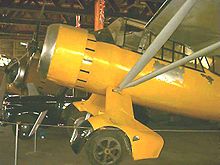
Picture - Westland Lysander Mk IIIA at the Commonwealth Air Training Plan Museum, Brandon, Manitoba, Canada
A small number of Lysanders are preserved in museums in the UK and Canada and elsewhere. The National Air and Space Museum, Smithsonian Institution, in the Udvar-Hazy Center located in the Chantilly, Virginia, suburb of Washington DC near Dulles International Airport has a Westland Lysander Mk IIIA on display, painted in the markings of No. 138 Squadron RAF (famed for their clandestine missions in wartime Europe).
A number are in museums in Canada including a Mk III (serial no. R9003) at the Canada Aviation and Space Museum in Ottawa, Canada. This example is a composite of three aircraft and was restored by the RCAF as a Centennial project in 1967.
A Mk III (serial no. 2363) is in flying condition at the Canadian Warplane Heritage Museum in Ontario. It flew for the first time following its restoration a few weeks before the Museum's Flyfest on 20-21 June 2009, and was flown publicly for the first time at that event. It is finished in a yellow & black 'bumblebee' target tug scheme.
A Lysander Mk IIIT was also on display at the Commonwealth Air Training Plan Museum, Brandon, Manitoba, Canada until July 2003 when it was disassembled and shipped to a museum in Portugal. Like many of the Lysanders that were retained in Canada as training aircraft, it was resplendent in bright "trainer" yellow.
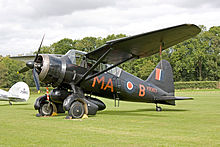
Picture - Westland Lysander at the Shuttleworth annual air show at Old Warden in 2009
One of the world's last airworthy Lysanders is part of the Shuttleworth Collection based at Old Warden Airfield, Bedfordshire. It is a regular at several vintage air shows, including the Shuttleworth displays and "Flying Legends" at Duxford.
A Lysander Mk IIIT (serial no. 1589) is a Canadian-built trainer on display at the Indian Air Force Museum (IAFM) at Palam, New Delhi.
A Canadian built Mk III, construction number 1206, formerly RCAF s/n 2365, registered C-GVZZ, is being flown by Vintage Wings of Canada. It is painted in No. 400 "City of Toronto" RCAF Squadron markings. After a full restoration, she first flew June 18, 2010 in Gatineau, QC.
In Belgium, OO-SOT is being restored to flying condition.
Specifications (Lysander Mk III)
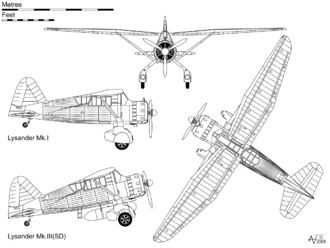
Picture - Orthographic projection of the Lysander Mk I, with profile view of the Mk.III(SD) covert operations aircraft.
Data from Westland Aircraft since 1915
General characteristics
Crew: One, pilot
Capacity: 1 passenger (or observer)
Length: 30 ft 6 in (9.29 m)
Wingspan: 50 ft 0 in (15.24 m)
Height: 14 ft 6 in (4.42 m)
Wing area: 260 ft² (24.2 m²)
Empty weight: 4,365 lb (1,984 kg)
Max takeoff weight: 6,330 lb (2,877 kg)
Powerplant: 1x Bristol Mercury XX radial engine, 870 hp (649 kW)
Performance
Maximum speed: 212 mph (184 knots, 341 km/h) at 5,000 ft (1,520 m)
Range: 600 miles (522 nmi, 966 km)
Service ceiling: 21,500 ft (6,550 m)
Climb to 10,000 ft (3,050 m): 8 min
Take-off run to 50 ft (15 m): 305 yards (279 m)
Armament
Guns: Two forward-firing .303 in (7.7 mm) Browning machine guns in wheel fairings and two .303 Lewis guns for the observer
Bombs: Four 20 lb (9 kg) bombs under rear fuselage and 500 lb (227 kg) of bombs on stub wings if fitted
Comparable aircraft
Fieseler Fi 156 Storch
L-4 Grasshopper
Henschel Hs 126
Bibliography
Donald, David and Jon Lake, eds. Encyclopedia of World Military Aircraft. London: AIRtime Publishing, 1996. ISBN 1-880588-24-2.
"For Army Co-operation." Flight, 9 June 1938, pp. 569-576.
Hall, Alan W. Westland Lysander, Warpaint Series No. 48. Luton, Bedfordshire, UK: Warpaint Books Ltd., 2005. ISBN 970-000000-704-7.
James, Derek N. Westland Aircraft since 1915. London: Putnam, 1991. ISBN 0-85177-847-X.
James, Derek N. Westland: A History. Gloucestershire, UK: Tempus Publishing Ltd, 2002. ISBN 0-7524-2772-5.
Kightly, James. Westland Lysander. Redbourn, UK: Mushroom Model Publications, 2006. ISBN 83-917178-4-4.
March, Daniel J. British Warplanes of World War II. London:Aerospace Publishing, 1998. ISBN 1-874023-92-1.
Mason, Francis K. The Westland Lysander, Aircraft in Profile Number 159. Leatherhead, Surrey, UK: Profile Publications, 1967. No ISBN.
Milberry, Larry. Aviation in Canada. Toronto: McGrawHill Ryerson Limited, 1979. ISBN 0-07082-778-8.
Mondey, David. Westland (Planemakers 2). London: Jane's Publishing Company, 1982. ISBN 0-7106-0134-4.
OvÄx”Äxk, Michal and Karel Susa. Westland Lysander Mks.I, II, III/IIIA, III(SD)/IIIA(SD), TT Mks. I, II, III. Prague, Czech Republic: Mark 1 Ltd., 1999. ISBN 80-902559-1-4.
Robertson, Bruce. Lysander Special. Shepperton, Surrey, UK: Ian Allan Ltd., 1977. ISBN 0-7110-0764-0.
"Some talk of Alexander..." Part 1. Air International, January 1984, Vol. 26, No. 1. ISSN 0306-5634. pp. 21-28.
"Some talk of Alexander" Part 2. Air International, February 1984, Vol. 26, No. 2. ISSN 0306-5634. pp. 80-87.
Taylor, John W.R. "Westland Lysander." Combat Aircraft of the World from 1909 to the present. New York: G.P. Putnam's Sons, 1969. ISBN 0-425-03633-2.
Westland Lysander Pictures and Westland Lysander for Sale.
Living Warbirds: The best warbirds DVD series.
Source: WikiPedia